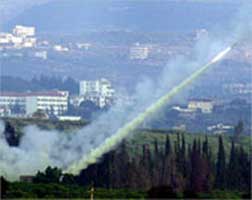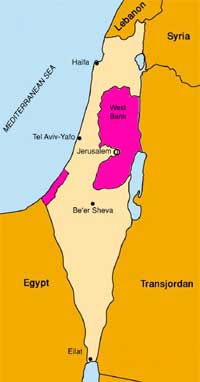The 2006 Israel-Lebanon conflict.
(summarized from Wikipedia)


The 2006 Israel-Lebanon
conflict started on 12 July 2006. The conflict began with a
cross-border Hezbollah raid and shelling, which resulted in the capture
of two and killing of three Israeli soldiers. Israel held the Lebanese
government responsible for the attack because it was carried out from
Lebanese territory. Israel initiated an air and naval blockade,
air strikes across much of the country, and ground incursions into
southern Lebanon. Hezbollah then continuously launched rocket attacks
into northern Israel and engaged the Israeli Army on the ground with
hit-and-run guerrilla attacks. The conflict killed over 1000 Lebanese,
mainly civilians, and over 150 Israelis, mainly soldiers, and caused
widespread damage to Lebanon's infrastructure. It also displaced about
a million Lebanese and 500,000 Israelis and disrupted normal life
across all of Lebanon and northern Israel.
On 11 August, the United Nations Security Council unanimously approved United Nations Security Council Resolution 1701 to end the conflict. A ceasefire came into effect at 05:00 UTC, 14 August 2006. Although violations of the ceasefire have occurred from both sides, fighting has largely ceased.
On 17 August, the Lebanese army began deploying its forces in southern Lebanon as part of the agreement, and Israel began to withdraw some of its forces from the country. A full withdrawal is not expected until the enlarged UNIFIL force has arrived.
(Note* This was written in 2006. After the ceasefire, Hezbollah became more popular because they helped the people of Lebanon more than the government did. It could be said that Israel's attacks had a reverse effect. They wanted to make Hezbollah unpopular. Israel was also criticized worldwide for using too much power and killing civilians. In particular, their use of cluster bombs was considered inhumane.)
-August 19, 2006-
On Saturday, in a pre-dawn raid, Israeli soldiers seized Nasser al-Shaer at his home in Ramallah in the occupied West Bank. Al-Shaer is the Palestinian Deputy Prime Minister and a top official of the Hamas militant group.
The Israeli military confirmed the detention of al-Shaer. Israel has been cracking down on the Hamas movement, which does not recognize Israel, for the last seven weeks. Al-Shaer is the highest ranking Hamas member to be detained. 30 members of Palestinian National Authority parliament have also been detained during the crack-down.
Nasser al-Shaer, a former university professor, is known as a pragmatist in Hamas. Palestinian officials accused Israel of undermining their efforts to form a broad government coalition.
The West Bank was captured by Israel from Jordan in the 1967 Six-Day War and is considered by the United Nations and most countries to be under Israeli occupation. Some Israelis and various other groups prefer to refer to it as "disputed" rather than "occupied" territory.

On 11 August, the United Nations Security Council unanimously approved United Nations Security Council Resolution 1701 to end the conflict. A ceasefire came into effect at 05:00 UTC, 14 August 2006. Although violations of the ceasefire have occurred from both sides, fighting has largely ceased.
On 17 August, the Lebanese army began deploying its forces in southern Lebanon as part of the agreement, and Israel began to withdraw some of its forces from the country. A full withdrawal is not expected until the enlarged UNIFIL force has arrived.
(Note* This was written in 2006. After the ceasefire, Hezbollah became more popular because they helped the people of Lebanon more than the government did. It could be said that Israel's attacks had a reverse effect. They wanted to make Hezbollah unpopular. Israel was also criticized worldwide for using too much power and killing civilians. In particular, their use of cluster bombs was considered inhumane.)
Top Hamas official seized by Israel
(From Wikinews)
(From Wikinews)
(Originally, the Palestinians lived in
the area that is now Israel. The West Bank territory is one of the two
areas the Palestinians moved to after Israel became a country. Israel
now occupies the West Bank. Since January 2006, eHamasf has been the
majority Palestinian political party in the West Bank. Hamas believes
Israel should be given back to the Palestinians and the new ePalestinef
should become an Islamic state.)
-August 19, 2006-
On Saturday, in a pre-dawn raid, Israeli soldiers seized Nasser al-Shaer at his home in Ramallah in the occupied West Bank. Al-Shaer is the Palestinian Deputy Prime Minister and a top official of the Hamas militant group.
The Israeli military confirmed the detention of al-Shaer. Israel has been cracking down on the Hamas movement, which does not recognize Israel, for the last seven weeks. Al-Shaer is the highest ranking Hamas member to be detained. 30 members of Palestinian National Authority parliament have also been detained during the crack-down.
Nasser al-Shaer, a former university professor, is known as a pragmatist in Hamas. Palestinian officials accused Israel of undermining their efforts to form a broad government coalition.
The West Bank was captured by Israel from Jordan in the 1967 Six-Day War and is considered by the United Nations and most countries to be under Israeli occupation. Some Israelis and various other groups prefer to refer to it as "disputed" rather than "occupied" territory.

Click here to see an interesting slideshow made by a person from Israel. What does it mean?
(Note* Both Hamas and Hezbollah are
considered dangerous by the world because they don't consider Israel to
be a real country. However, both groups are popular among the people in
their countries. Hamas was elected to be the government of the occupied
territories. However, both Israel and the U.S. refused to consider them
the real government.)
